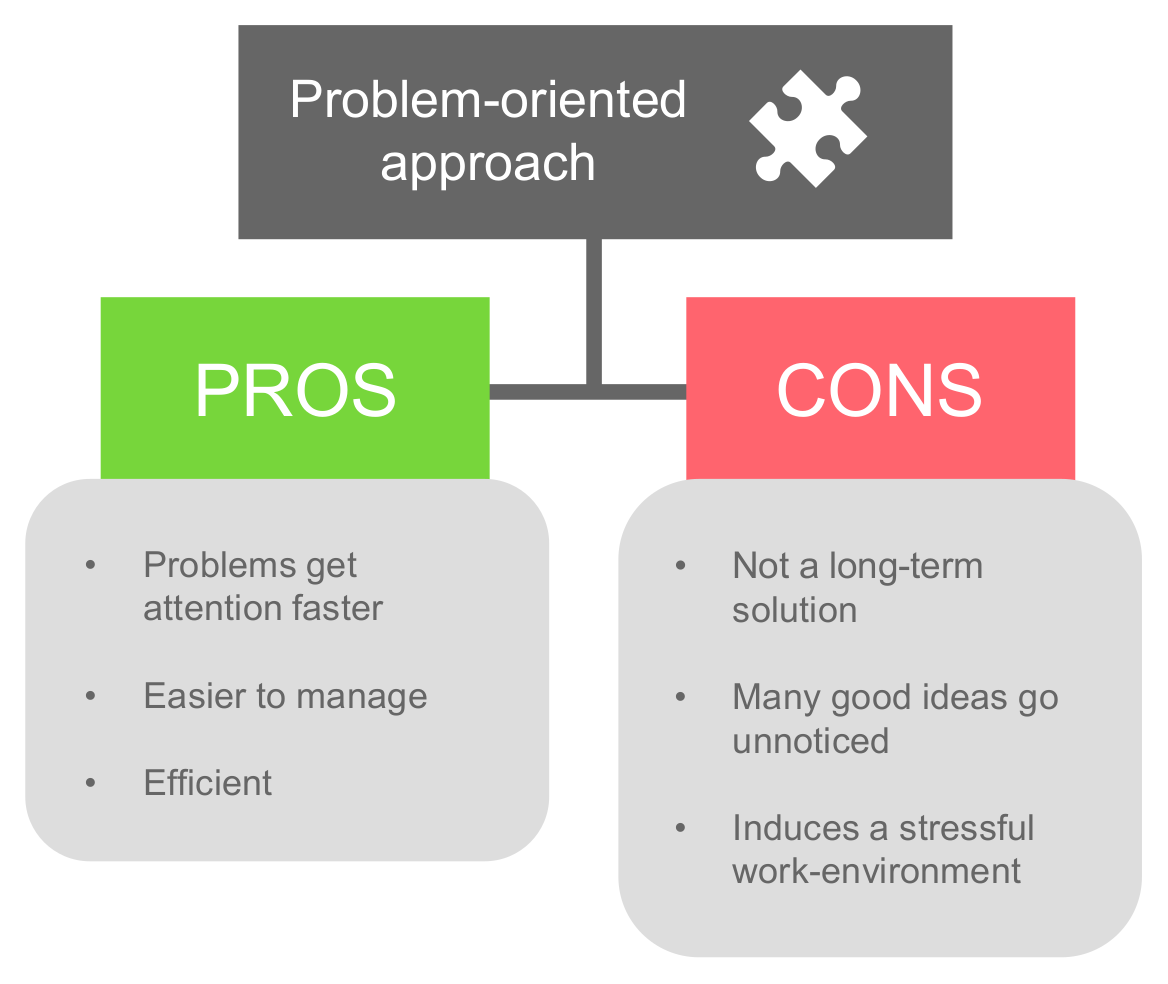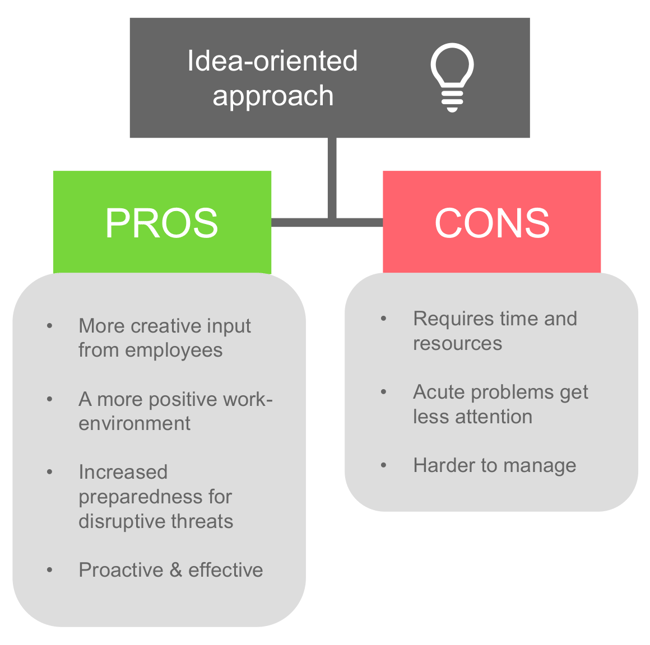Generating Ideas or Focusing on Problems?
People typically tend to look for solutions by focusing on the problems at hand, but is that truly athe best approach? Although straightforward, it might not be the most effective way to find sustainable solutions to long-term issues. In fact, it has been shown that just by focusing on the positive implications that solving your problem may have, you can stimulate your brain to find solutions in an entirely new way.
Anthony Jack along with his colleague Richard Boyatzis conducted a study in 2013 where by brain scanning two separate focus groups, they we’re able to determine the differing effects NEAs (negative emotional attractor) and PEAs (positive emotional attractor) have on the human psyche From this we can deduce that positivity induces effectiveness, at least on an individual level. But could this formula of positive reinforcement work on a larger scale, say an organization?

Acknowledging Your Emotional Derivatives
"If you provide a robot with a clear set of instructions, you can be reasonably confident that the task will be carried out effectively. However, human cognition is much more complex. It is not enough to simply tell people what they need to do. "
This quote from the book Exponential by James Hewitt and Aki Hintsa crystallizes the point I’m trying to make. By simply seeing only the problem in front of yourself and asking, “What can I do about this?” rarely generates effective solutions, or at least very long-lasting ones. For example, the book portrayed a case of a middle-aged man with problems caused by dangerously poor living habits, trying to turn his life around. His attempts of motivating lasting change through arguments, like: “I need to get rid of my back aches” weren’t very effective. However, when the focus was steered towards the vision of living a life full of energy with his loved ones, the motivator was much more powerful. So, to break it down: Having a deeper emotional incentive creates motivation that appears to be superior to that of objective rational assessment.
So, why exactly is it that we always think the best way to fix everything is by forcing our brains to generate spot-on answers to things that are clearly never quite that simple? The answer to this resides in our culture and the way we perceive the expectations it holds for us. Simply put: people are expected to act like machines, so they try to fit the description. Although some people appear to function like robots, these “superhumans” simply have better emotional self-control and ability to maintain focused attention. This doesn’t mean that everyone should be able to manipulate their emotions with such unwavering talent. For most of us, the best way to look at problem-solving is by focusing on positive and far-reaching goals.

Power of Positive Reinforcement
When you approach problems, not by looking for direct solutions, but by focusing on larger goals and their positive implications, you adjust your mind to view things from a much broader angle. This way of thinking comes more naturally than trying to focus on something very specific and purging out a key that perfectly fits the lock. To back this theory up, there’s also a biological explanation for this.
Referring to the aforementioned study on the effects of PEAs and NEAs on brain activity, it appears that positive attractors activated regions that are associated with future planning and feelings of being rewarded. Along with this, it led to the parasympathetic nervous system taking control, as opposed to the NEA triggered sympathetic nervous system, which is the “fight or flight” mechanism that keeps us in a state of stress and agitation. This parasympathetic domination caused a decrease in blood pressure and heart rate, resulting in a state of relaxation.
“When we do not feel threatened, our mind considers that it’s safe to take time over decisions and think more deeply. We become more cognitively flexible, able to stimulate multiple future possibilities and consider new ideas, as well as taking into account how other people think and feel”
– James Hewitt & Aki Hintsa, Exponential
In a nutshell, human design favors optimism. Solving problems from the viewpoint of the problem itself is a negative way of thinking and thus triggers stress and tunnel-vision. Although having a certain level of stress is often good for executing time-sensitive tasks that demand focus, in a dominantly problem-oriented mindset stress is also present in tasks where it is nothing but an unnecessary nuicance that depletes energy.
If simply forcing a smile from day to day can provenly make you happier, why set limitations to what a positive mentality can achieve. Understanding the colorful world of how different psychological triggers affect individuals could potentially have benefits far beyond just the individual. On the scale of a large organization, this knowledge could even be used to make significant changes in the way we look at problem-solving. The collective strength in changing group mentality should never be overlooked, as it can be a very useful tool in improving anything that ultimately relies on everone's individual effort.

The Big Picture
When many small streams collide, fortifying one another in cumulative momentum, a river is born. One can easily stop a single stream with virtually no effort. But when faced with a large river, the flow will likely win the match.
The same applies when changing workplace culture. If it’s simply about someone making a personal change, it’s likely to have little impact on the whole. However, if many people change their collective perspective, the effects are likely to echo throughout the entire company.
Referring back to the studies on how eliminating the typical problem-oriented mentality worked on an individual level, we can only imagine what would happen if this mentality was applied on a larger scale.
Power in Ideas
So how exactly could mere positivity help an orgnization solve problems?
Now, it's not about throwing away discipline and painting rainbows on the walls, hoping that suddenly all your problems will vanish. It's about altering the way we view problems towards a more positive and uninhibited way of thinking. We believe that the best way to encourage this kind of collective positivity is by focusing efforts on generating ideas instead of just solutions to existing problems. By this, I mean that you don't necessarily always try to fix something that is broken, but rather try to improve something that could work even better. Of course, there are always urgent issues that must be fixed right away, but slowly by portioning efforts towards a more proactive approach of generating ideas, you avoid always being one step behind your problems. We will refer to this mentality as idea-orientation, as opposed to problem-orientation.
In medicine, you don't treat the symptoms, you treat the disease. However, some symptoms must be dealt with so that the clock doesn't run out.
With work problems it is just as advantageous to treat the "disease" instead of just addressing the symptoms. The more people start innovating, the more you start to find that many of those ideas not only fix current problems, but proactively nip future ones in the bud. This doesn't only include small-scale everyday problems, but also larger issues that are often difficult to solve after gaining cumulative destructive momentum. All-in-all, proactive "problem-solving" through innovation decreases the overhead and stress of constantly "putting out fires" as they emerge.

From Solving to Evolving
What's wrong with trying to fix what needs fixing?
When you start off with the premise that you have to come up with a solution to a specific problem, it not only works as major work-related stressor, but also often automatically eliminates a vast portion of potentially viable ideas by steering your thought process towards finding that one perfect idea. Over time, this may end up suffocating creativity and subsequently causing a more narrow-minded view on finding solutions to problems; problems that may in fact have a very easy solution if viewed from an entirely different angle.
Groundbreaking ideas often aren't generated on the spot, or even for specific purposes. The best of the bunch might often be molded through a lengthy process and even then may end up having a completely different use than what it was originally thought for. It's impossible to think of every scenario and application that ideas may have, beforehand. Only by starting to generate and pilot ideas, can you ultimately find out where they may take you.
However, this is not to say that just by getting everyone to share their thoughts you can make all your problems disappear. Especially for large organizations with a clear existing process for managing ideas or innovation, suddenly having plenty of new ideas to consider might even feel like it will only make things worse. It's thus crucial to start by focusing on strategically important areas where new ideas are much more likely to make a truly worthwhile impact.
Adding Innovation to The Mix
How do I facilitate innovation in a way that doesn't disrupt current processes?
There isn't a simple one-size-fits-all answer for a company to adapt a more idea-oriented mentality, as fitting innovation into the equation is largely dependent on the industry and size of the company, as well as existing processes. To break it down, we have two opposites:
- Typically older and larger organizations that have clear processes in place which are crucial for being able to operate in an effective manner at that scale.
- Startups that can easily adopt new processes and change their business model on the fly, it's thus much easier to benefit from bold ideas.
With older and larger organizations, it's often difficult to initially facilitate such a process in an intuitive manner. However, if successful, it can also be a game changer, as with more people come more ideas. When bringing ideation into the equation, it must happen in a way that doesn't bring all systems to a complete halt. Getting the process right requires finding the right balance between problem-orientation and idea-orientation. Meaning that there should be enough direct problem solving to get immediate results to acute problems, which “keeps the ship on course,” but enough ideation to keep the organization nimble and open-minded towards improvements, potentially eliminating future disruptive threats. Thus, the focus should, especially in the beginning, only be on the most important areas of improvement and then gradually move on to more general ideation as the organization adapts to the idea-oriented mentality. Keep in mind that this is a matter of long-term commitment to positive change. After all, “Rome wasn’t built in a day.” To make this all happen, it is crucial to have motivated people who are up for the challenge, as well as a tool that makes the actual ideation and idea management as effortless as possible.

With smaller companies the situation is somewhat different. Although they also have their fair share of metaphorical "fires" to put out, and these fires are naturally more acute and influential than in larger organizations, smaller companies are much more prone to change due to their infancy. Stable and standardized processes that inhibit change are not yet carved in stone, unlike in larger organizations, which makes adopting new processes that support innovation easier. Thus, smaller companies must also find the right balance between problem-orientation and idea-orientation. Meaning that there must be focus on putting out fires that are strategically important, but bravely adding innovation into the equation on the side.
Ideas can have a much larger impact on smaller companies than large conglomerates and at the same time it is much easier to integrate innovation to work well with the existing processes. This makes it twice as benefitial.

Final Thoughts
“A butterfly could flap its wings and set molecules of air in motion, which would move other molecules of air, in turn moving more molecules of air— eventually capable of starting a hurricane on the other side of the planet.”
― Andy Andrews, The Butterfly Effect: How Your Life Matters
Just like the butterfly in the famous quote, even something as small of a change in an organization’s culture as positivity can have such significant impacts that they are nigh impossible to comprehend beforehand. By committing to making small changes that reinforce a more positive idea-oriented mentality, whilst still attending to the necessities, you are likely to cause a ripple effect that has far-reaching implications beyond your wildest expectations.
Interested in Innovation and Leadership?
Subscribe to our blog to get the latest stories on innovation, leadership and culture straight to your inbox.







